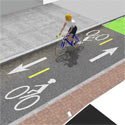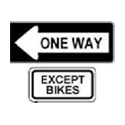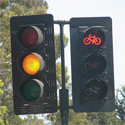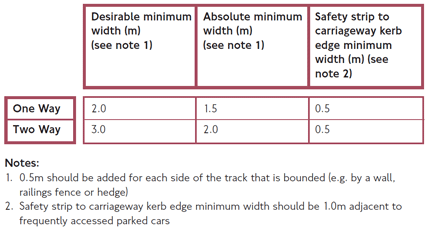I rode Dearborn today...anyone else?
I just missed the press conference and just hung out at lunch to see how it would all work. It seemed easy enough, so I took Dearborn as my starting route home to Roscoe Village. Normally I hit Franklin to Orleans then north to Lincoln.
I have to say, it was pretty easy and relatively safe. The ambassadors were helpful with the the auto traffic. The walkers were easy enough to avoid. I had to chuckle at two riders riding side by side in the lane.
What I didn't see was any oncoming traffic; southbound riders. I am guessing that will come in time or at other times during the day.
Way to go Mayor RE! This is really making a statement.
Who else rode the new path?
Tags:
Replies to This Discussion
-
Permalink Reply by Alex Z on April 23, 2013 at 9:51am
-
How does it not reduce bike/MV intersection conflicts? If everyone follows the traffic lights, there should be zero conflict. I realize that's a big "if," but do you just mean that we cannot reasonably expect people to follow the traffic signals?
Kevin C said:It's another bad PBL design/implementation in Chicago. It not only fails to reduce bike/MV conflict at intersections, it actually makes the existing intersections worse
-
Permalink Reply by Duppie on April 23, 2013 at 10:21am
-
How does your inability to time lights become the fault of the bike lane? ;)
Timing has to work not just for bikes, but for northbound cars and crossing traffic as well.
You can adjust your speed up or down to make more lights. It does require some getting used to, like looking ahead to the next block, judging your distance from the next intersection and guessing how long it will take for the light to turn green again. Based on that you speed up or slow down somewhat. But with a little effort it is possible.
That it is possible, and that is largely a matter of timing, is further evidenced by the fact that I can usually get near 30 green lights out of the 39 lights on my commute. Except when it is really windy, and I struggle to keep the "correct" speed. I promptly hit 5-10 more red lights.
Mark said:+1 to Kevin. I decided to give the Dearborn PBL another chance on Sunday and hit a light just turning red at every intersection all the way along.
[snip]
-
Permalink Reply by Anne Alt on April 23, 2013 at 10:30am
-
On most Loop streets, it's difficult to go more than one or two blocks without hitting a red light. This isn't unique to Dearborn.
-
Permalink Reply by Tricolor on April 23, 2013 at 11:52am
-
I've seen a few people standing in the path at intersection waiting for a crossing sign, but I've also seen more bikes violating their red signal than cars violating the red arrow for left turns (one of them was a cop and they run reds everywhere so they don't count).
Maybe bikes on Dearborn need a front mounted speaker playing a catchy music loop. The theme from Jaws, for example.
-
Permalink Reply by Michelle S on April 23, 2013 at 12:56pm
-
I disagree that it's a bad design. The implementation was kind of hurried because they really wanted it in last year. It's currently not perfect, with potholes and puddles, but they can be fixed. I don't find that it's too narrow, and I've seen no more debris than in a traditional bike lane (except for the snow willfully shoveled in by building workers). To me, besides the potholes and puddles, the most challenging aspect has been the vehicles parked in the lane, and the pedestrians standing in the lane, but that's due to a combo of lack of familiarity as well as the presence of the lane not being visible enough, and again, that can/will be helped with better markings. The pedestrian issue will not go away any time soon and maybe never. I noticed last year in Amsterdam that bicyclists constantly had to ring their bells to warn pedestrians (tourists, mainly) not to step into their path.
Kevin C said:It's another bad PBL design/implementation in Chicago. It not only fails to reduce bike/MV conflict at intersections, it actually makes the existing intersections worse AND creates new conflict points at alleys along its length.
etc
-
Permalink Reply by spencewine on April 23, 2013 at 2:06pm
-
When the PBL went in, the bi-directional path was my biggest concern, but I have found it a non-issue. I have ridden it almost daily since it went in and the bike traffic tends to follow a general pattern, at least to/from Madison. Bikes head South in the morning, and head North in the evening with a couple exceptions. It is still early in Spring, so that may change, but I'm not counting on it.
Kevin C said:It's another bad PBL design/implementation in Chicago. It not only fails to reduce bike/MV conflict at intersections, it actually makes the existing intersections worse AND creates new conflict points at alleys along its length. The lanes are too narrow, and their proximity to pedestrian traffic ensures that there will be increased bike/pedestrian conflict for as long as this PBL exists. Roadways are "crowned." Debris from the road funnels to the curb. Putting bikes against the curb virtually guarantees that bikes will be relegated to riding through puddles, ice, snow, broken glass, beer bottles, cans, burrito wrappers, medical waste, etc.
Here's an excerpt from a Copenhagenize blog entry from April 14th: (The emphasis was added by me).
Interestingly, in this article, you've basically seen three of the four types of bicycle infrastructure in Denmark that makes up the Best Practice. There are only four. That's what makes good design.
- Separated cycle tracks. The standard when speed limits for cars are above 30 km/h - unless car traffic volume is deemed low then above 40 km/h. Separated from the street with a curb.
- Bi-directional cycle tracks. Not used in cities because of safety issues. We threw these out of the Best Practice for cities a couple of decades ago. They serve a great function on routes with few intersections, like along the motorways or bike paths that run through parks, etc.
- Cycle tracks separated by a verge - completely away from the road, but running parallel. This is the standard when speed limits for cars are 60-70 km/h or higher.
The one you didn't see is what you get on residential streets with a 20-30 km/h speed limit. Then there is no bicycle infrastructure. Bicycles share the street with other vehicles at that speed.
Michelle Stenzel said:I'm a little sick of stopping to advise drivers that they're parked in the Dearborn bike lane but have continued to do so because I think it will take hundreds of us doing this a few thousand times before it sinks into the collective conscience of Chicago drivers. Plus, I'm hoping for (and will be following up on the DOT promise of) better markings added this spring/summer, because that will help. Right now, if a driver is unfamiliar with Dearborn and only sees half a block of it, it's admittedly hard to tell that it's a protected bike lane.
-
Permalink Reply by Kevin C Dormant on April 23, 2013 at 2:06pm
-
From GridChicago 12/14/12, "[t]he bike lanes, four-foot-wide northbound and five-foot southbound, look narrow, but actually they’re surprisingly comfortable."
From NACTO Design Guidelines (Two way cycle tracks):
The desirable two-way cycle track width is 12 feet. Minimum width in constrained locations is 8 feet.
Each lane is 1-2 feet narrower than the NACTO "desirable" width; or 0-1 foot wider than the "minimum width in constrained locations." Each lane is 1.5-2.5 feet narrower than the Netherlands' Cycle Track Width Guidelines. Each lane is 1.5-2.5 feet narrower than the Transport of London "absolute minimum width" for two way bike lanes. If you factor in the curbside storm drains every 50-60 feet, the effective width of the southbound lane is further narrowed. I call that too narrow.
And while I'm at it, here's a list of the NACTO requirements for two-way cycle tracks:
Required Features 
Bicycle lane word, symbol, and/or arrow markings (MUTCD Figure 9C-3) shall be placed at the beginning of a cycle track and at periodic intervals along the facility to define the bike lane direction and designate that portion of the street for preferential use by bicyclists. 
If configured on a one-way street, a “ONE WAY” sign (MUTCD R6-1, R6-2) with “EXCEPT BIKES” plaque shall be posted along the facility and at intersecting streets, alleys, and driveways informing motorists to expect two-way traffic. 
A “DO NOT ENTER” sign (MUTCD R5-1) with “EXCEPT BIKES” plaque shall be posted along the facility to only permit use by bicycles. 
Intersection traffic controls along the street (e.g., stop signs and traffic signals) shall also be installed and oriented toward bicyclists traveling in the contra-flow direction. CDOT included 1 out of 4?
Michelle Stenzel said:I disagree that it's a bad design. The implementation was kind of hurried because they really wanted it in last year. It's currently not perfect, with potholes and puddles, but they can be fixed. I don't find that it's too narrow, and I've seen no more debris than in a traditional bike lane (except for the snow willfully shoveled in by building workers). [snip]
-
Permalink Reply by Michelle S on April 23, 2013 at 2:49pm
-
Yes, it's less than the most desirable width, but more than the minimum width required. Maybe in a few years we'll have a matching southbound PBL on Clark, and then the Dearborn PBL can be converted to a one-way northbound track.
And I can think of 3 of those 4 required features already being present. Maybe there are One Way Except Bikes signs, but I haven't looked for them.
-
Permalink Reply by Lisa Curcio on April 23, 2013 at 3:14pm
-
I ride a part of it every day. It does not seem too narrow. Yes, alleys and driveways can be a problem, but they are a problem for cars and pedestrians, too. Common sense dictates that one slow down and watch for cars turning into or out of uncontrolled alleys and driveways. As time passes, I very seldom see a car turn against the red left turn signal. I do think there could be better signs for the cars with the red turn signals, but the drivers are figuring it out. Just today, however, I saw three cyclists ignore the red signal for the bike lanes. There are drivers, pedestrians and cyclists who are all very special and do not need to obey the signals. We just don't know who they are until they show themselves.
-
Permalink Reply by Adam Herstein on April 24, 2013 at 3:35am
-
Implementing a green wave would be a nice project for this year. :-)
Anne Alt said:On most Loop streets, it's difficult to go more than one or two blocks without hitting a red light. This isn't unique to Dearborn.
-
Permalink Reply by Anne Alt on April 24, 2013 at 5:19am
-
CDOT tried for a green wave but found that, given the tight spacing of intersections and the need for left turn arrows at westbound streets, it wasn't possible.
Adam Herstein (5.5 mi) said:Implementing a green wave would be a nice project for this year. :-)
Anne Alt said:On most Loop streets, it's difficult to go more than one or two blocks without hitting a red light. This isn't unique to Dearborn.
Groups
-
Chicagoland Beer Explora…
203 members
-
Wednesday Night for Mort…
1 member
-
Great Lakes Ultra Cycling
270 members
-
Major Taylor Internation…
1 member
-
Critical Mass discussion
261 members

